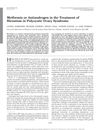Androstanediolglucuronide: A Parameter for Peripheral Androgen Activity Before and During Therapy with Cyproterone Acetate
April 1991
in “
European journal of endocrinology
”
TLDR 3α-AdiolG is a good marker for androgen activity in women with excessive hair growth and decreases with anti-androgen treatment.
In a study from April 1991, serum levels of 5α-androstane-3α,17β-diolglucuronide (3α-AdiolG) were measured in 25 female patients with excessive hair growth (hirsutism) due to idiopathic causes, polycystic ovary syndrome, or 21-hydroxylase deficiency, and compared with 13 healthy women. The study found that patients with hirsutism had significantly higher levels of 3α-AdiolG than the control group, with median levels of 5.3 nmol/l in the idiopathic hirsutism group, 8.5 nmol/l in the polycystic ovary syndrome or 21-hydroxylase deficiency group, and 2.9 nmol/l in the control group. No correlation was found between 3α-AdiolG levels and body fat. Treatment with the anti-androgen drug cyproterone acetate, alone or with ethinylestradiol, significantly reduced both 3α-AdiolG levels and hirsutism scores. The study concluded that 3α-AdiolG is a useful marker for peripheral androgen activity in women with hirsutism both before and during anti-androgen therapy.
